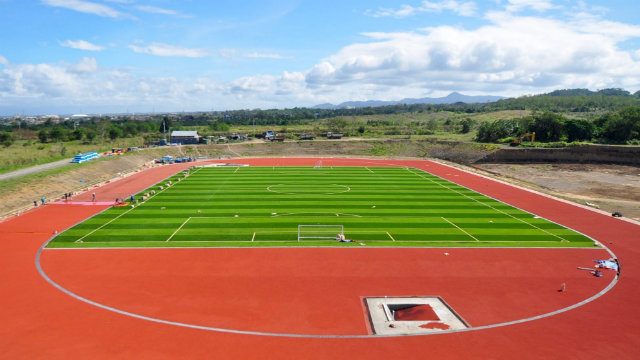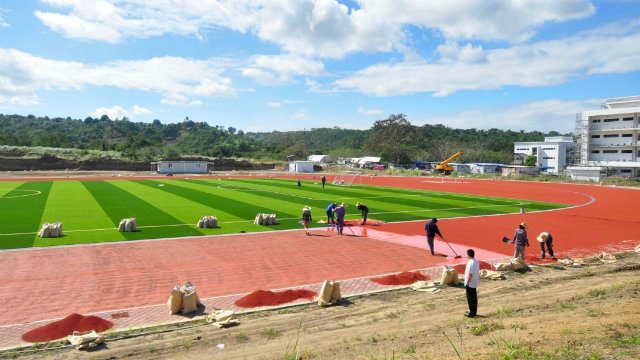SUMMARY
This is AI generated summarization, which may have errors. For context, always refer to the full article.

MANILA, Philippines – Yup, they are starting to pop up everywhere.
Yet another artificial football field has emerged near greater Manila. Tucked away in the corner of the 51-hectare De La Salle University Science and Technology Complex in Santa Rosa, the new pitch will add to the growing list of synthetic football venues in the country.
“We hope these two projects, (they are also making another grass pitch), are seen as La Salle’s small contribution to the development of Philippine football and athletics,” says DLSU’s Associate Vice-Chancellor for Campus Development, Jay Calleja.
The facility is the second artificial football pitch in Laguna after the one set up by the local government unit in Biñan.
De La Salle’s Santa Rosa field is surrounded by an IAAF-standard track. There is 3 meters of room between the track and the lines of the field, and the field proper is 100m long by 64m wide. That is considered to be the minimum size for international play, and, to my knowledge, the same size as the Chelsea/Gatorade Blue Pitch in The Circuit.
FIFA’s preferred size is 68m by 105m, but this field size is adequate for most uses. The good part is that there is a very large buffer zone between the edges of the field and the track, which makes it safer. A player jostling for the ball near the edge of the field would likely fall on grass and not on the track if he was nudged off the park.
A typical 105m by 68m field inside a track, like the one in Rizal Memorial, has its corners intruding slightly into the track. A nice compromise would have been 66m by 102m, as in Biñan, but that would have eaten into the buffer between the track and the pitch.
The grass itself is Pro-Turf TBF-35005 PE Monofilament “Thiolon” yarn. Raffy Reloza, the school principal, says it is from China. In fact, some of the workers supervising the installation are Chinese. The blades of grass are 50 mm long, a wee bit shorter than the 60mm blades in McKinley Hill and Rizal. Biñan’s plastic grass is also 50 mm.
The contractor is Firmbuilders, who specializes in other sports surfaces, like basketball floors and athletic tracks. It is believed this is their first synthetic grass field in the country.
The pitch already has infill granules in it, and it feels quite good underfoot. Maybe not as cushy as Rizal Memorial, which has a plastic “shockdrain” underneath, but quite comparable to the McKinley Hill and Turf BGC surfaces. Most certainly its better than the rather firm turf in the FEU Diliman and DLS- Zobel fields. This one is also clearly softer than the Blue Pitch.
There are no immediate plans to have it tested for a FIFA “1 Star” or “2 Star” rating. One Star pitches are recommended for recreational play and suitable for the qualification rounds for major, elite tournaments. FIFA prefers that the final stage of a big tournament is played on a Two Star pitch, like Rizal Memorial.
Like the FEU facility, there are alternating bands of light and dark green on the pitch that sort of simulate the grain of real grass when its mowed one way along a certain stretch and then the other way right beside it. It’s a nice touch, and will likely be appreciated by assistant referees who could use the stripes as a visual aid to help them judge offside calls.
The school already has plans for a grandstand on one side of the pitch and lighting as well. Calleja says the school will assess the need for those after a year and then decide on when to construct them. The architectural firm of Nazareno + Guerrero, (no relation to the author), has come up with the design.
Calleja says the school has done its homework on the grandstand, which he asserts will be similar in size to the Rizal Memorial grandstand. The stand, its locker rooms, and the lighting, will all follow FIFA guidelines. Calleja points out that they will follow FIFA’s regional TV standard in their lighting. The drainage underneath the field also follows FIFA’s recommendations.
As of the moment there is ample room for parking if needed for a big event, with plenty of open space beside and near the field. Right now there is just one narrow dirt road leading to the pitch.

Might the field host football festivals, or even pro matches or even Azkals games? Calleja is non-committal.
“The needs of the students, especially our varsity teams, will be prioritized. Still, we intend our new facilities to be resources to the athletes and residents in the area, as well as the relevant sports associations,” is his measured reply.
Incredibly, this isn’t the only pitch the school is building in the campus. While the synthetic pitch gets laid in, work is already beginning on a natural grass field beside the integrated school, (high school and grade school), nearer the entrance to the campus. That pitch, also a 100m by 64m, is meant for the Physical Education classes and varsity squad of the integrated school. It will also have some lighting, but probably not competition-grade. Firmbuilders is also in charge of that field.
A school with one grass pitch and another artificial one is certainly a dream situation for any program.
The school is also renovating a nearby covered basketball facility. It has two courts side-by-side, and I pointed out to Reloza that a regulation 40m by 20m futsal court could be accommodated there. Reloza says they will put a synthetic surface over that court, which is currently cement.
Laguna is thus poised to be a center of excellence for football in the south of Manila. Biñan already has a pitch, there are several grass football pitches in Nuvali, where the Pilipinas Cup was held, and now this. Nearby Carmona, in Cavite, is slated to become the home to a PFF national training center. The Laguna towns of Los Baños and Santa Cruz have already produced UFL players and could churn out some more.
Aside from the varsity high school team, there is also a youth football club in the Santa Rosa area, Green Barons, that is composed of DLSU-STC varsity players. Perhaps down the road this facility could host a Laguna team in the proposed national league.
Slowly but surely, people are coming round to the advantages of artificial turf. They need far less maintenance and water, can be used more frequently, can be rented out regularly for profit, and are smoother in general than fragile grass, thus promoting better skill and more attractive football. The Dutch, French, Scottish, and North American top tiers already have teams that play on them. The very traditional English and German leagues have yet to follow suit.
Hopefully subsequent artificial pitches can incorporate new ideas, like pre-laid-in lines to divide the field into four pitches for small-sided festival play. Or best yet, organic infill, made of coconut husk or tree bark. Singapore’s Jalan Besar Stadium utilizes this technology already. Organic infill is supposed to give a much more natural, grass-like bounce.
At any rate, the artificial grass revolution continues in Philippine football. – Rappler.com
Special thanks to Integrated School principal Raffy Reloza, Jay Calleja, Project Manager Marc Macatangay, and Lead Engineer Ronnie Gallardo for their help in this article.
Follow Bob on Twitter @PassionateFanPH.
Add a comment
How does this make you feel?
There are no comments yet. Add your comment to start the conversation.